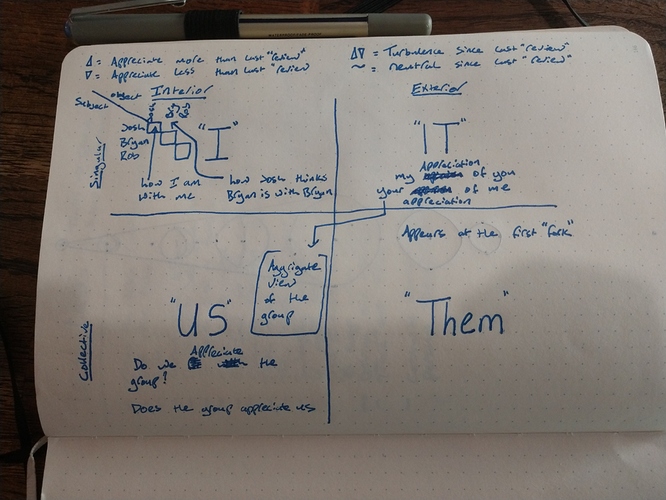Mindfulness Meter / Appreciative feedback signalling
Because consensus reality is violent and makes us dumb!
Harmonisation
Having tied a number of non-prescriptive experiments during our dream-along (aka Hack-along v0.01 - iteratively renamed because “Its sooo fractal man!”) we tried several modes of non-prescriptive operation. Most of these tests failed, but we took away practically applied patterns and learnings about what didn’t work and why!
Appreciative feedback
That said, an untried experiment which participants agreed seemed promising was the notion of appreciative feedback (stemming from Integral Theory).
Appreciation is a chosen “current-see” to optimise for as it seems a good unit of account to encompass and summarise the many complexities of human interaction:
Scenario: Thanks for the hug, I felt hurt by that snarky comment you just made but you seem under stress so perhaps I should cook tonight — thanks for purchasing the food.
From above you can probably infer that everything contains a value and balancing the books can sometimes be tricky. Ideally though we want to arrive at a place where we can intersubjectively appreciate ourselves, life and others in a harmonious balance.
The appreciative experiment is essentially a game of mindfulness that allows intentional individuals to make inferences from generalised group feedback to bridge the self actualisation gap. It’s important that we practice this stuff so the multidimensional mirror should really just be taken as a mature honest look at ourselves — feedback is nothing personal, someone is volunteering its provision for our benefit (and they don’t have to, neither do you have to accept it).
Lets remember:
You are playing with friends;
whether you like them or not;
whether they like you, or not;
whether we know it or not.You can show someone how to look, but not to see.
You can show someone how to listen, but not to hear.
- Guitar Craft Aphorisms (the whY’s)
Helping each-other
As people are generally inconsistent we should weigh the subjects feedback against their previous session, and use generalised feedback metrics that are as simple as possible.
The entry options are: appreciating the relationship more since last feedback (^), appreciating the relationship less since last feedback (V), appreciating the relationship neutrally but its been turbulent (^V), appreciate the relationship the same and its been neutral calm seas ( — )!
Four-quadrants
Integral theory is a tool for fluidly viewing and understanding the world in multiple dimensions. We take a subject and divide it into four quadrants based on frame; interior personal “I”, exterior personal “it”, interior group “us” and exterior group “them.” Please see the picture above 
Interior Personal (click)
This quadrant represents the “personal personal” and the “extra-person personal.” This means how we feel in ourselves or how others think we feel in ourselves.
The former is most likely a cornerstone to doing well in all quadrants but since “we cannot know ourselves” it’s also good to allow others to reflect how they think we are doing with ourselves.
Use this quadrant:
• First; find your name in the subject list, your responses should all be placed on this row.
• Second; find your name in the object list.
• Fill this intersection with how you feel in yourself. Choose a symbol that represents your state change since joining the hack-along; do you appreciate yourself more(^), less (V), neutrally the same ( — ) or turbulently the same (^V)?
• Now, still in the same quadrant along the object row you can choose to fill in data on how you see others perceiving themselves during the hack-along: do they appreciate themselves more, less, neutrally the same or turbulently the same since you got to know them?
Exterior Personal (click)
This quadrant should represent peers interacting to a third party. Do we generally appreciate each others actions more, less, neutrally or have we ridden a wave of turbulence?
The information can be used immediately by individuals to act on and foster good relationships; depending on the data the appropriate response should probably range from p2p conflict resolution to drinks at the pub. Maybe both.
In conjunction with data from the interior singular quadrant participants should be able to infer A LOT of information about their relationships.
Interior collective
Currently out of our experiments scope, but could be indicative of group cohesiveness. Theres a number of interesting metrics that can be derived here and when cohesion is low its likely we would see emergent groups form.
Exterior collective
This is how other groups rate inter-group cohesion. Some emergent tribes may gel, others less so — this allows communities to communicate. It could also be used as means to allow external supporters to signal their preferences.



